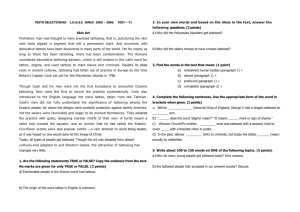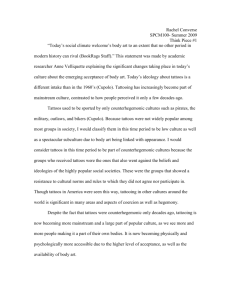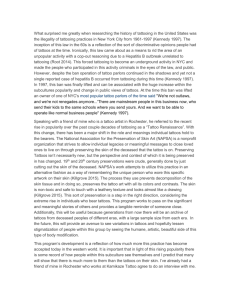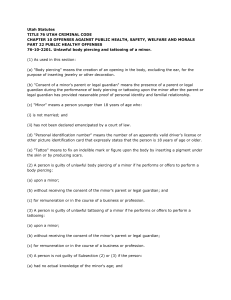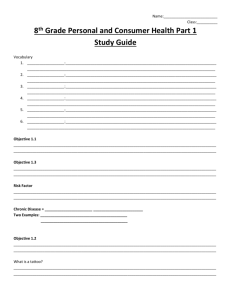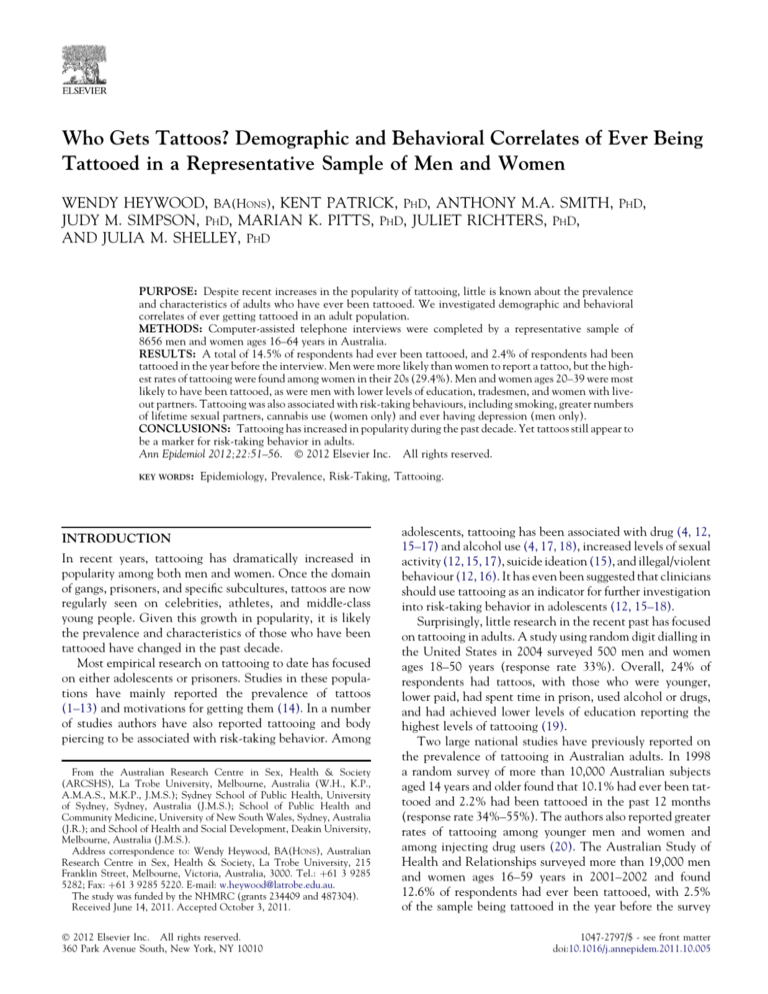
Who Gets Tattoos? Demographic and Behavioral Correlates of Ever Being
Tattooed in a Representative Sample of Men and Women
WENDY HEYWOOD, BA(HONS), KENT PATRICK, PHD, ANTHONY M.A. SMITH, PHD,
JUDY M. SIMPSON, PHD, MARIAN K. PITTS, PHD, JULIET RICHTERS, PHD,
AND JULIA M. SHELLEY, PHD
PURPOSE: Despite recent increases in the popularity of tattooing, little is known about the prevalence
and characteristics of adults who have ever been tattooed. We investigated demographic and behavioral
correlates of ever getting tattooed in an adult population.
METHODS: Computer-assisted telephone interviews were completed by a representative sample of
8656 men and women ages 16–64 years in Australia.
RESULTS: A total of 14.5% of respondents had ever been tattooed, and 2.4% of respondents had been
tattooed in the year before the interview. Men were more likely than women to report a tattoo, but the highest rates of tattooing were found among women in their 20s (29.4%). Men and women ages 20–39 were most
likely to have been tattooed, as were men with lower levels of education, tradesmen, and women with liveout partners. Tattooing was also associated with risk-taking behaviours, including smoking, greater numbers
of lifetime sexual partners, cannabis use (women only) and ever having depression (men only).
CONCLUSIONS: Tattooing has increased in popularity during the past decade. Yet tattoos still appear to
be a marker for risk-taking behavior in adults.
Ann Epidemiol 2012;22:51–56. Ó 2012 Elsevier Inc. All rights reserved.
KEY WORDS:
Epidemiology, Prevalence, Risk-Taking, Tattooing.
INTRODUCTION
In recent years, tattooing has dramatically increased in
popularity among both men and women. Once the domain
of gangs, prisoners, and specific subcultures, tattoos are now
regularly seen on celebrities, athletes, and middle-class
young people. Given this growth in popularity, it is likely
the prevalence and characteristics of those who have been
tattooed have changed in the past decade.
Most empirical research on tattooing to date has focused
on either adolescents or prisoners. Studies in these populations have mainly reported the prevalence of tattoos
(1–13) and motivations for getting them (14). In a number
of studies authors have also reported tattooing and body
piercing to be associated with risk-taking behavior. Among
From the Australian Research Centre in Sex, Health & Society
(ARCSHS), La Trobe University, Melbourne, Australia (W.H., K.P.,
A.M.A.S., M.K.P., J.M.S.); Sydney School of Public Health, University
of Sydney, Sydney, Australia (J.M.S.); School of Public Health and
Community Medicine, University of New South Wales, Sydney, Australia
(J.R.); and School of Health and Social Development, Deakin University,
Melbourne, Australia (J.M.S.).
Address correspondence to: Wendy Heywood, BA(HONS), Australian
Research Centre in Sex, Health & Society, La Trobe University, 215
Franklin Street, Melbourne, Victoria, Australia, 3000. Tel.: þ61 3 9285
5282; Fax: þ61 3 9285 5220. E-mail: w.heywood@latrobe.edu.au.
The study was funded by the NHMRC (grants 234409 and 487304).
Received June 14, 2011. Accepted October 3, 2011.
Ó 2012 Elsevier Inc. All rights reserved.
360 Park Avenue South, New York, NY 10010
adolescents, tattooing has been associated with drug (4, 12,
15–17) and alcohol use (4, 17, 18), increased levels of sexual
activity (12, 15, 17), suicide ideation (15), and illegal/violent
behaviour (12, 16). It has even been suggested that clinicians
should use tattooing as an indicator for further investigation
into risk-taking behavior in adolescents (12, 15–18).
Surprisingly, little research in the recent past has focused
on tattooing in adults. A study using random digit dialling in
the United States in 2004 surveyed 500 men and women
ages 18–50 years (response rate 33%). Overall, 24% of
respondents had tattoos, with those who were younger,
lower paid, had spent time in prison, used alcohol or drugs,
and had achieved lower levels of education reporting the
highest levels of tattooing (19).
Two large national studies have previously reported on
the prevalence of tattooing in Australian adults. In 1998
a random survey of more than 10,000 Australian subjects
aged 14 years and older found that 10.1% had ever been tattooed and 2.2% had been tattooed in the past 12 months
(response rate 34%–55%). The authors also reported greater
rates of tattooing among younger men and women and
among injecting drug users (20). The Australian Study of
Health and Relationships surveyed more than 19,000 men
and women ages 16–59 years in 2001–2002 and found
12.6% of respondents had ever been tattooed, with 2.5%
of the sample being tattooed in the year before the survey
1047-2797/$ - see front matter
doi:10.1016/j.annepidem.2011.10.005
52
Heywood et al.
WHO GETS TATTOOS?
Selected Abbreviations and Acronyms
AOR Z adjusted odds ratio
CI Z confidence interval
AEP Vol. 22, No. 1
January 2012: 51–56
Possible responses included at a parlor/professional in
Australia, chemist/beauty salon/hairdresser in Australia, at
home/friend’s, in prison, overseas, and overseas in prison.
Procedure
(response rate 73%) (21). Both Australian studies reported
greater rates of tattooing among men.
Despite recent increases in the profile and popularity of
tattooing, little is known about characteristics of individuals
who get tattoos. Furthermore, it is not known whether tattooing is still a marker for risk-taking behavior in adults.
The current study used a representative sample of Australian
men and women ages 16–64 years to report demographic and
behavioral differences between those who have and have not
been tattooed, with particular interest in risk-taking behaviors. In Australia, restrictions and regulations for tattooing
and other forms of skin penetration are the responsibility
of each State and Territory. Age of consent for tattooing
varies from 16 years in New South Wales to 18 years in
most other States; the Northern Territory has no specific
legislation regarding age of consent. States also differ on
whether tattoo premises need to be registered, standards of
care and infection control and training requirements (22).
METHODS
Recruitment
The present study was a component of the Australian Longitudinal Study of Health and Relationships (23). This study
surveyed 4290 men and 4366 women in all states and territories of Australia in 2004–2005.
Survey
Respondents were asked a range of sociodemographic questions, including age, education, occupation, partner status,
residential location, country of birth, and sexual identity.
Participants were next asked a series of behavioral questions,
including use of tobacco, alcohol, and cannabis; ever been
told by a doctor you have depression; and ever had a sexually
transmitted infection (self-reported diagnosis of chlamydia,
genital herpes, genital warts, syphilis, gonorrhoea, pelvic
inflammatory disease, bacterial vaginosis, trichomoniasis.
or pubic lice). Questions about lifetime numbers of sexual
partners (any form of sexual experience) were also asked
about opposite and same-sex partners. These responses
were combined to calculate total lifetime sexual partners.
Finally, participants were asked ‘‘have you ever been tattooed?’’ Those who said yes were then asked, ‘‘were any of
your tattoos done in the last 12 months?’’ Respondents
who indicated they had a tattoo done in the last 12 months
were asked ‘‘where did you go to have the last tattoo done?’’
The survey was conducted during 2004 and 2005 by the use
of computer-assisted telephone interviewing. Stratified by
sex, a sample of households was drawn by the use of random
digit dialling, as described previously (24). After having the
study explained to them, participants either gave their
verbal consent to be interviewed or refused. Of those contacted, 56.0% agreed to participate. Age was the only selection criterion used in this study, with participants
interviewed only if aged between 16 and 64 years. Where
two or more eligible respondents lived in a household,
a computer-generated algorithm randomly chose one to be
interviewed by birthday. All interviews were conducted in
English. Approval for this study was granted by the human
research ethics committees of La Trobe University, the
University of New South Wales, and Deakin University.
Data Analysis
All frequencies were weighted by household size and rounded
to the nearest integer. Because a test for interaction between
age and sex with the use of logistic regression showed that the
effect of age differed significantly by sex, correlates of tattooing were examined separately for men and women by the use
of logistic regression. Chi-squared tests were first used to
assess bivariate associations between ever been tattooed
and variables of interest for each sex. Variables were only
included in the initial multivariate logistic regression models
if bivariate analysis produced a p value less than .25. The least
significant variables were sequentially removed from the
models until all remaining variables were statistically significant at p ! .05. Removed variables were then checked one
at a time to ensure they were not significant in the final
model. All analyses were weighted by household size.
P-values reported are for design-based F statistics from the
weight-adjusted c2 tests (unadjusted) and Wald tests
(adjusted) of the overall effect of each factor. Effect estimates
are reported as adjusted odds ratios (AOR) with 95% confidence intervals (CI). Analyses were conducted using Stata,
version 10.1 (StataCorp, College Station, TX).
RESULTS
A total of 8656 men and women completed the interview; of
these respondents 14.5% had ever been tattooed. Overall,
men were significantly more likely than women to report
they had been tattooed (15.4% vs. 13.6%, p Z .03), but
the effect of sex differed by age (p ! .001). A greater prevalence of tattooing was found in 20- to 29-year-old women
AEP Vol. 22, No. 1
January 2012: 51–56
FIGURE 1. Prevalence of ever getting a tattoo by age and sex.
than in 20- to 29-year-old men (p Z .008), whereas among
men, tattooing was more common in the older age groups
(40–49 years, p ! .001; 50þ years, p ! .001; Fig. 1).
Overall, 2.4% of respondents had been tattooed in the
year before the interview. Of these, 90.7% reported being
tattooed by a professional, 3.6% reported being tattooed at
home or at a friend’s house and 3.2% had been tattooed
overseas. The rest were tattooed at a chemist or clinic.
Characteristics of Men Who Have Tattoos
Demographic correlates of ever having been tattooed for men
are displayed in Table 1. Age, education, and occupation
were associated with having been tattooed after adjusting
for other demographics and behaviors. Almost one in four
men ages 30–39 years reported having a tattoo. Compared
with these men, those younger than the age of 20 and those
aged 40 or more were significantly less likely to have been
tattooed. Increasing levels of education reduced the likelihood of men reporting tattoos, while tradesmen were more
likely to have a tattoo than professionals. Sexual identity
was not associated with having been tattooed.
A number of behaviors were associated with having
a tattoo for men. Men who smoked had twice the odds of
having been tattooed. Men with more lifetime sexual partners
were more likely to have a tattoo, eg, 1 in 25 men who reported
one sex partner or none reported a tattoo compared to 1 in 4
men who reported 11 or more lifetime sexual partners (AOR,
5.06; 95% CI, 3.15–8.13). Men who reported ever being told
by a doctor they have depression had 1.3 times the odds of
having a tattoo after adjusting for all other variables.
Characteristics of Women Who Have Tattoos
Demographic and behavioral correlates of ever been tattooed for women are displayed in Table 2. Age, education,
and partner status were all associated with being tattooed.
Compared with women aged 30–39 years, women younger
than the age of 20 and those aged 40 or older were less likely
Heywood et al.
WHO GETS TATTOOS?
53
to have been tattooed. Women with postsecondary education were also less likely to have been tattooed, whereas
women who reported having a regular partner they did not
live with were more likely to have been tattooed. Similar
to men, sexual identity was not associated with having
been tattooed after adjusting for the other variables.
After adjusting for all other variables, women who
currently used tobacco and those who had used cannabis
in the last 12 months were more likely to have been tattooed
than women who did not use tobacco or cannabis.
Increasing number of lifetime sex partners was also associated with a greater likelihood of being tattooed: 3% of
women who reported one sex partner or none reported being
tattooed compared to 30% of women with 11 or more lifetime sex partners (AOR, 6.41; 95% CI 4.13–9.96).
DISCUSSION
Tattoos have become increasingly prominent in Australia as
evidenced by three large national studies. Studies in 1998
(20), 2001–2002 (21), and the current study in 2004–2005
have reported prevalences of 10%, 13%, and 15%, respectively. Furthermore, tattooing does not appear to be
confined to certain subpopulations, with men and women
in every demographic reporting having tattoos.
Certain groups were, however, more likely to have been
tattooed. The overall finding that men were more likely
than women to have been tattooed is consistent with the
two previous Australian studies (20, 21) but contradicts a small
study among adults in the United States (19) and a number of
adolescent studies (10, 12, 13) in which the authors found no
differences between males and female subjects.
Despite these overall findings, gender differences were
found in certain age groups. A greater proportion of women
in their 20s reported getting a tattoo, whereas in the older
age groups tattoos were more common among men. Furthermore, tattooing was most popular among 20- to 39–year-old
respondents. Although we do not have data on the age at
which subjects got a tattoo, these findings show changing
patterns and motivations for getting tattoos in the community. In the 1960s, 1970s, 1980s and early 1990s when the
oldest respondents were most likely tattooed and tattooing
was a male-dominated practice, motivated by group affiliations such as gangs and prisoners and confined to certain
subcultures (14, 25, 26). More recently however, in a 2007
review authors found the most common reasons mentioned
in the literature related to embellishments of the body, art,
fashion, and individuality (14).
Tattooing was popular among men who had not finished
secondary school, tradesmen, and women who did not live
with their partners, whereas men and women who had
completed postsecondary education were less likely to
54
Heywood et al.
WHO GETS TATTOOS?
AEP Vol. 22, No. 1
January 2012: 51–56
TABLE 1. Demographic and behavioral correlates of ever getting a tattoo for 4290 men
% tattoo
Demographics
Age (4290)
16–19 (367)
20–29 (737)
30–39 (810)
40–49 (1054)
50 þ (1322)
Education (4289)
Less than secondary (1056)
Secondary/college (2205)
Postsecondary (1028)
Occupation (4202)
Professional (1594)
Associate professional (823)
Tradesperson (1151)
Unskilled (634)
Residential location (4228)
Cities/metro (2196)
Regional/remote (2032)
Country of birth (4288)
Australia (3313)
Overseas (975)
Partner status (4290)
No partner (989)
Live-out partner (465)
Live-in partner (2836)
Sexual identity (4290)
Heterosexual (4187)
Other (103)
Behavior
Current smoker (4284)
Nonsmoker (3221)
Smoker (1063)
Alcohol use (4289)
None (629)
Less than weekly (1149)
Weekly to daily (2511)
Cannabis 12m (4281)
No (3795)
Yes (486)
Depression (4270)
No (3668)
Yes (602)
Lifetime sex partners (4177)
0–1 (707)
2–5 (1191)
6–10 (907)
11þ (1372)
History of STI (4290)
No (3601)
Yes (689)
5.4
22.3
23.2
16.3
8.7
21.7
16.8
5.6
9.4
15.0
23.1
18.1
13.7
17.1
15.6
14.7
15.0
17.5
15.1
15.3
17.6
10.7
29.6
12.1
17.9
15.0
13.5
29.9
14.3
22.0
4.2
10.7
16.4
24.4
14.2
21.6
Unadjusted OR
Adjusted OR*
p ! .001
0.19 (0.10–0.35)
0.95 (0.73–1.23)
–
0.64 (0.51–0.81)
0.32 (0.24–0.41)
p ! .001
1.37 (1.12–1.67)
–
0.29 (0.22–0.39)
p ! .001
–
1.69 (1.29–2.21)
2.89 (2.32–3.59)
2.13 (1.60–2.82)
p Z .004
–
1.30 (1.08–1.55)
p Z .53
–
0.93 (0.75–1.16)
p Z .50
0.99 (0.79–1.24)
1.19 (0.87–1.62)
–
p Z .54
–
1.18 (0.69–2.02)
p ! .001
0.27 (0.14–0.55)
1.03 (0.77–1.39)
–
0.60 (0.46–0.77)
0.33 (0.25–0.44)
p ! .001
1.58 (1.25–1.99)
–
0.38 (0.28–0.52)
p ! .001
–
1.08 (0.81–1.45)
1.70 (1.33–2.17)
1.22 (0.87–1.70)
p Z .26
–
1.13 (0.92–1.39)
p Z .11
–
1.23 (0.95–1.58)
p Z .07
0.73 (0.55–0.95)
0.88 (0.63–1.25)
–
p Z .77
–
0.91 (0.50–1.68)
p ! .001
–
3.53 (2.93–4.24)
p Z .008
–
1.58 (1.17–2.14)
1.28 (0.96–1.69)
p ! .001
–
2.74 (2.17–3.45)
p ! .001
–
1.70 (1.36–2.11)
p ! .001
–
2.74 (1.70–4.40)
4.49 (2.81–7.17)
7.38 (4.70–11.57)
p ! .001
–
1.67 (1.35–2.06)
p ! .001
–
2.04 (1.65–2.51)
p Z .04
–
1.24 (0.88–1.75)
0.93 (0.67–1.29)
p Z .18
–
1.21 (0.92–1.59)
p Z .04
–
1.30 (1.01–1.67)
p ! .001
–
2.07 (1.26–3.38)
3.18 (1.95–5.18)
5.06 (3.15–8.13)
p Z .07
–
1.25 (0.98–1.60)
AOR Z adjusted odds ratio; CI Z confidence interval; STI Z sexually transmitted infection.
*AORs and 95% CIs for having a tattoo vs not having a tattoo. Adjusted for age, education, occupation, use of tobacco, alcohol, depression, and lifetime number of sex partners.
have a tattoo. Similar findings relating to education attainment were also reported in the U.S. national study (19).
Having been tattooed also correlated with certain risktaking behaviors, most notably smoking, cannabis use, and
greater numbers of lifetime sexual partners. Associations
between tattooing and risk-taking behavior have also been
reported in studies among adults (19) and adolescents
(4, 12, 15–18). Although the direction of the relationship
AEP Vol. 22, No. 1
January 2012: 51–56
Heywood et al.
WHO GETS TATTOOS?
55
TABLE 2. Demographic and behavioral correlates of ever getting a tattoo for 4366 women
% tattoo
Demographics
Age (4366)
16–19 (318)
20–29 (697)
30–39 (975)
40–49 (1091)
50 þ (1285)
Education (4365)
Less than secondary (1212)
Secondary/college (2083)
Post-secondary (1070)
Occupation (4252)
Professional (1454)
Associate Professional (1654)
Tradesperson (182)
Unskilled (962)
Residential location (4309)
Cities/metro (2200)
Regional/remote (2109)
Country of birth (4365)
Australia (3427)
Overseas (938)
Partner status (4366)
No partner (981)
Live-out partner (463)
Live-in partner (2922)
Sexual identity (4366)
Heterosexual (4257)
Other (109)
Behavior
Current smoker (4361)
Non-smoker (3381)
Smoker (980)
Alcohol use (4366)
None (1136)
Less than weekly (1510)
Weekly to daily (1720)
Cannabis 12m (4359)
No (4089)
Yes (270)
Depression (4361)
No (3336)
Yes (1025)
Lifetime sex partners (4202)
0–1 (1197)
2–5 (1628)
6–10 (788)
11 þ (589)
History of STI (4366)
No (3639)
Yes (727)
6.9
29.4
22.3
9.8
3.3
13.5
15.5
10.0
9.8
15.2
14.9
17.3
13.2
13.9
14.5
10.3
14.3
25.6
11.4
13.3
24.0
9.1
29.2
10.1
16.3
13.6
11.8
40.4
12.7
16.4
3.3
11.4
20.3
30.0
12.5
19.1
Unadjusted OR
Adjusted OR*
p ! .001
0.26 (0.14–0.47)
1.45 (1.14–1.84)
–
0.38 (0.29–0.49)
0.12 (0.08–0.17)
p ! .001
0.86 (0.69–1.06)
–
0.60 (0.47–0.78)
p ! .001
–
1.64 (1.31–2.06)
1.60 (1.01–2.55)
1.91 (1.49–2.46)
p Z .51
–
1.06 (0.88–1.28)
p Z .002
–
0.68 (0.53–0.86)
p ! .001
1.30 (1.03–1.63)
2.66 (2.03–3.49)
–
p Z .01
–
2.06 (1.19–3.57)
p ! .001
0.30 (0.15–0.57)
1.41 (1.08–1.86)
–
0.37 (0.28–0.50)
0.14 (0.09–0.20)
p ! .001
1.15 (0.89–1.50)
–
0.52 (0.39–0.69)
p Z .83
–
1.09 (0.83–1.42)
1.04 (0.60–1.82)
1.16 (0.84–1.61)
p Z .10
–
1.20 (0.97–1.49)
p Z .63
–
0.93 (0.71–1.23)
p Z .03
1.24 (0.94–1.63)
1.49 (1.08–2.05)
–
p Z .70
–
1.14 (0.58–2.23)
p ! .001
–
4.12 (3.40–5.00)
p ! .001
–
1.74 (1.35–2.23)
1.41 (1.09–1.80)
p ! .001
–
5.07 (3.82–6.71)
p Z .005
–
1.35 (1.10–1.66)
p ! .001
–
3.76 (2.53–5.59)
7.41 (4.93–11.13)
12.48 (8.32–18.74)
p ! .001
–
1.65 (1.33–2.06)
p ! .001
–
2.57 (2.03–3.25)
p Z .08
–
1.31 (0.99–1.75)
1.05 (0.77–1.42)
p Z .003
–
1.70 (1.20–2.39)
p Z .81
–
0.97 (0.76–1.24)
p ! .001
–
2.66 (1.76–4.02)
4.40 (2.85–6.78)
6.41 (4.13–9.96)
p Z .61
–
0.93 (0.71–1.22)
AOR Z adjusted odds ratio; CI Z confidence interval; STI Z sexually transmitted infection.
*AOR and 95% CIs for having a tattoo versus not having a tattoo. Adjusted for age, education, partner status, use of tobacco and cannabis, and lifetime number of sex partners.
between tattooing and risk-taking behavior in adults is not
currently known, it may be that in some groups tattooing
still represents and is associated with resistance and rebellion towards more conservative parts of society.
Strengths of this study are the large sample size and the
representative nature of the sample. Limitations include
reliance on self-report and social desirability bias. The
current study says nothing about motivations for being
56
Heywood et al.
WHO GETS TATTOOS?
tattooed, the size, location, type and number of tattoos
a respondent has, or whether the respondent has had or
would like to have their tattoo/s removed. Future research
investigating these topics would enrich understandings of
current tattoo practices in the community.
Tattooing appears to have moved into mainstream
society, with roughly one in seven Australian adults reporting having been tattooed. Despite the recent gentrification
of tattooing, tattoos still appear to be associated with risktaking behavior in adults. Although the risk of acquiring
blood-borne virus infections such as hepatitis C and HIV
during tattooing is relatively small, greater awareness of
how to avoid these risks is still needed.
We thank Jason Ferris for assistance with data management and the
Hunter Valley Research Foundation for data collection.
REFERENCES
1. Abiona TC, Balogun JA, Adefuye AS, Sloan PE. Body art practices among
inmates: Implications for transmission of bloodborne infections. Am J
Infect Control. 2010;38:121–129.
2. Benjamins LJ, Risser WL, Cromwell PF, Feldmann J, Bortot AT, Eissa
MA, et al. Body art among minority high school athletes: Prevalence,
interest and satisfaction; parental knowledge and consent. J Adolesc
Health. 2006;39:933–935.
3. Braithwaite R, Robillard A, Woodring T, Stephens T, Arriola KJ. Tattooing and body piercing among adolescent detainees: Relationship to alcohol
and other drug use. J Subst Abuse. 2001;13:5–16.
4. Brooks TL, Woods ER, Knight JR, Shrier LA. Body modification and
substance use in adolescents: Is there a link? J Adolesc Health.
2003;32:44–49.
5. Cegolon L, Mastrangelo G, Mazzoleni F, Majori S, Baldovin T, Xodo C.
Body art in 4,277 Italian secondary school adolescents: Prevalence and
associations with personal and family characteristics. Fam Med.
2010;42:273–279.
6. Deschesnes M, Demers S, Fines P. Prevalence and characteristics of body
piercing and tattooing among high school students. Can J Public Health.
2006;97:325–329.
7. Hellard ME, Aitken CK, Hocking JS. Tattooing in prisonsdNot such
a pretty picture. Am J Infect Control. 2007;35:477–480.
8. Mayers L, Chiffriller S. Sequential survey of body piercing and tattooing
prevalence and medical complication incidence among college students.
Arch Pediatr Adolesc Med. 2007;161:1219–1220.
AEP Vol. 22, No. 1
January 2012: 51–56
9. Mayers LB, Chiffriller SH. Body art (body piercing and tattooing) among
undergraduate university students: ‘‘Then and now.’’. J Adolesc Health.
2008;42:201–203.
10. Mayers LB, Judelson DA, Moriarty BW, Rundell KW. Prevalence of body
art (body piercing and tattooing) in university undergraduates and incidence of medical complications. Mayo Clin Proc. 2002;77:29–34.
11. Preti A, Pinna C, Nocco S, Mulliri E, Pilia S, Petretto DR, et al. Body of
evidence: Tattoos, body piercing, and eating disorder symptoms among
adolescents. J Psychosom Res. 2006;61:561–566.
12. Roberts TA, Ryan SA. Tattooing and high-risk behavior in adolescents.
Pediatrics. 2002;110:1058–1063.
13. Stieger S, Pietschnig J, Kastner CK, Voracek M, Swami V. Prevalence and
acceptance of tattoos and piercings: A survey of young adults from the
southern German-speaking area of Central Europe. Percept Mot Skills.
2010;110:1065–1074.
14. Wohlrab S, Stahl J, Kappeler PM. Modifying the body: Motivations for
getting tattooed and pierced. Body Image. 2007;4:87–95.
15. Carroll ST, Riffenburgh RH, Roberts TA, Myhre EB. Tattoos and body
piercings as indicators of adolescent risk-taking behaviors. Pediatrics.
2002;109:1021–1027.
16. Deschesnes M, Fines P, Demers S. Are tattooing and body piercing indicators of risk-taking behaviours among high school students? J Adolesc.
2006;29:379–393.
17. Oliveira MD, Matos MA, Martins RM, Teles SA. Tattooing and body
piercing as lifestyle indicator of risk behaviors in Brazilian adolescents.
Eur J Epidemiol. 2006;21:559–560.
18. Stephens MB. Behavioral risks associated with tattooing. Fam Med.
2003;35:52–54.
19. Laumann AE, Derick AJ. Tattoos and body piercings in the United States:
A national data set. J Am Acad Dermatol. 2006;55:413–421.
20. Makkai T, McAllister I. Prevalence of tattooing and body piercing in the
Australian community. Commun Dis Intell. 2001;25:67–72.
21. Grulich AE, de Visser RO, Smith AMA, Rissel CE, Richters J. Sex in
Australia: Injecting and sexual risk behaviour in a representative sample
of adults. Aust N Z J Public Health. 2003;27:242–250.
22. National Public Health Partnership. Regulation of Infection Control in
the Body Art Industry in Australia and New Zealand: A summary. 2002.
Available at: http://www.dhs.vic.gov.au/nphp/publications/legislation/bodyart.
pdf. Accessed February 21, 2011.
23. Smith AMA, Pitts MK, Shelley JM, Richters J, Ferris J. The Australian
longitudinal study of health and relationships. BMC Public Health.
2007;7(139).
24. Smith AMA, Rissel CE, Richters J, Grulich AE, de Visser RO. Sex in
Australia: the rationale and methods of the Australian Study of Health
and Relationships. Aust N Z J Public Health. 2003;27:106–117.
25. DeMello M. The convict body: Tattooing among male American
prisoners. Anthropol Today. 1993;9:10–13.
26. DeMello M. Bodies of inscription: A cultural history of the modern tattoo
community. Durham NC: Duke University Press; 2000.

